Seasons change and seasoning becomes lost
My day was filled in the “seasons of mists and mellow fruitfulness” October brings though not in my native England. Yes we had rain, but it was made the more lovely by visiting The Hancock Shaker Village again.
My day off was spent on a return visit to the Hankcock Shaker Museum. Though I felt like an English interloper from Manchester England, I derived a lot of pleasure in the reality that the way I was trained was identical to the way the Shaker craftsmen and women passed on their traditions of artisanry. Apprenticeship was a wonderful thing I now lament the loss of as we buy from other continents what could still be made locally. This thing we call progress tramples under foot the hearts and souls of men and in the UK we refer to certain types of work as soul-destroying work.
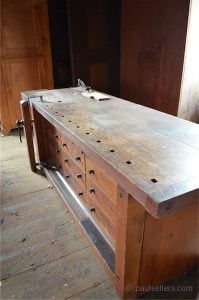
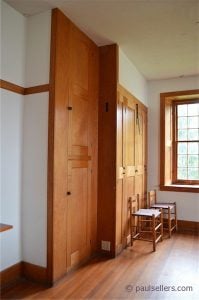
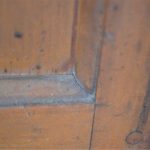
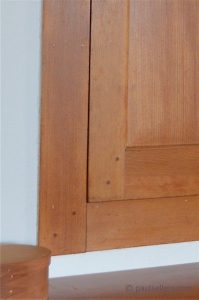
The Shakers observed an absolute essential we have utterly lost sight of in our modern-day mass-making. They recognized the value of not only drying wood but allowing it to season. One thing that was most evident in just about everything I saw was the minimized shrinkage between and within all of the components. This suggests to me that wood was milled and rough-cut, stickered and air-dried, and then further allowed to season, probably for several years regardless of thickness. As a boy I was taught to make sure wood was seasoned and not merely dried. We didn’t talk in realms of kiln dried only but seasoned and dried.
The reductive process of working wood
Woodworking was a reductive process of conversion, seasoning and drying. In the days and the places of Shaker workshops this cyclical process of conversion, seasoning and drying was acknowledged as the symbiotic absolute essential. How do I know? Well, shrinkage tells me a great deal about our forebears and the work they made from wood becomes apparent. Whereas the interior woodwork of all the buildings at HSV is exposed to minimalist heating, there is still shrinkage and expansion within woods used for making doors, boxes and cabinets. Typically, these early makers used European woodworking methods and technique and techniques I still use over 200 years later. 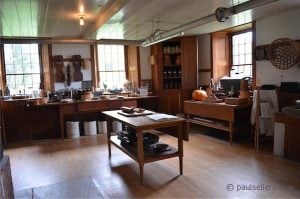
Concluding thoughts
At the end of my visit today I concluded that there was minimal shrinkage in all of the pieces I saw. Shoulder lines on doors were remarkably tight. The same doors, both large and small, fit within their frames with 1/16” tolerance everywhere I went and so too drawers within their recesses also. I loved the fact that so much was made from softer woods and that the work was so very vernacular to become Shaker styled.
For those who like to read John Keats:
Season of mists and mellow fruitfulness,
Close bosom-friend of the maturing sun;
Conspiring with him how to load and bless
With fruit the vines that round the thatch-eves run;
To bend with apples the moss’d cottage-trees,
And fill all fruit with ripeness to the core;
To swell the gourd, and plump the hazel shells
With a sweet kernel; to set budding more,
And still more, later flowers for the bees,
Until they think warm days will never cease,
For Summer has o’er-brimm’d their clammy cells.
Who hath not seen thee oft amid thy store?
Sometimes whoever seeks abroad may find
Thee sitting careless on a granary floor,
Thy hair soft-lifted by the winnowing wind;
Or on a half-reap’d furrow sound asleep,
Drows’d with the fume of poppies, while thy hook
Spares the next swath and all its twined flowers:
And sometimes like a gleaner thou dost keep
Steady thy laden head across a brook;
Or by a cyder-press, with patient look,
Thou watchest the last oozings hours by hours.
Where are the songs of Spring? Ay, where are they?
Think not of them, thou hast thy music too,—
While barred clouds bloom the soft-dying day,
And touch the stubble-plains with rosy hue;
Then in a wailful choir the small gnats mourn
Among the river sallows, borne aloft
Or sinking as the light wind lives or dies;
And full-grown lambs loud bleat from hilly bourn;
Hedge-crickets sing; and now with treble soft
The red-breast whistles from a garden-croft;
And gathering swallows twitter in the skies.


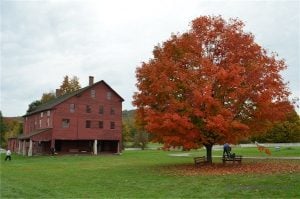
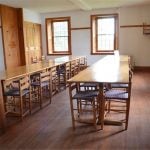
This has been a great series Paul, thanks. I was under the impression that air drying was one in the same as seasoning. Is there any set or guessed length of time that they would season the wood after drying it? Or is it just kind of a few years after drying?
the difference between air drting and kiln drying is that kiln drying reduces the moisture conent of the wood as rapidly as possible and the wood does not season in the process. On the other hand, air drying, which takes four to five time longer, both dries and seasons the wood. A good rule of thumb is a minimum of one year per 1″ of thickness. So a 1″ thick board is a ear of air drying, 2″ is two years and so on.
Is there any advantage working in air dried seasoned wood as opposed to kiln dried ?
There can be. It depends on the company drying the wood. Many smaller independent companies actually air dry for several months and get a cycle of stock going under shed roofs. They finish off the stock in the kiln and get it down to lower moisture levels. This wood rarely moves when you mill it. Force drying can be done quickly or more slowly. The better companies dry in the kiln more slowly whereas the cowboys dry it fast and we get the degrade without often knowing it. Force drying woods such as oak and cherry end up witha problem called case hardening and this often results in a problem below the surface known as honeycombing. Here the cells separate in subcutaneous checking which often cannot be seen.until the wood is milled or worked. generallt that’s not the case. You can feel the difference when wood is dried to rapidly though.